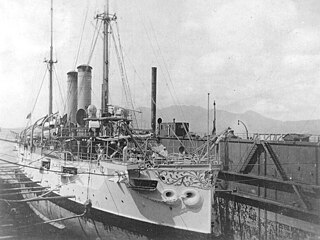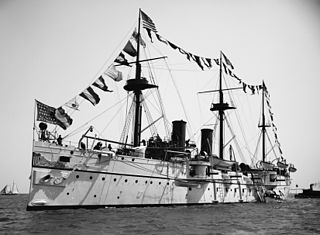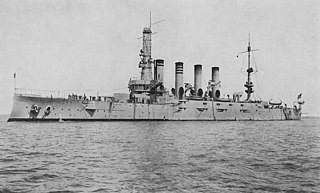 W
WThe three Chester-class cruisers were the first United States Navy vessels to be designed and designated as fast "scout cruisers" for fleet reconnaissance. They had high speed but little armor or armament. They were authorized in January 1904, ordered in fiscal year 1905, and completed in 1908. In 1920 all scout cruisers were redesignated as "light cruisers" (CL).
 W
WThe Denver-class cruisers were a group of six protected cruisers in service with the United States Navy from 1903 through 1929. Authorized by Congress in 1899 as part of the naval buildup touched off by the Spanish–American War, they were designed with peacetime duties on foreign stations and tropical service in mind, specifically patrolling Latin America and the Caribbean. However, they had insufficient armament, armor, and speed for combat with most other cruisers. Thus, they were also called "peace cruisers" and were effectively gunboats. They were intended to augment the Montgomery class in these roles.
 W
WThe Montgomery-class cruisers were three unprotected cruisers built for the United States Navy in the early 1890s. They had a thin water-tight protective deck, and also relied for protection upon their coal bunkers, cellulose packing, and numerous compartments. Roomy accommodations were provided for officers and crew, these cruisers being mainly intended for long cruises on distant stations.
 W
WThe first USS Annapolis (PG-10/IX-1) was a gunboat in the United States Navy. She was named for Annapolis, Maryland.
 W
WUSS Arkansas (BB-33) was a dreadnought battleship, the second member of the Wyoming class, built by the United States Navy. She was the third ship of the US Navy named in honor of the 25th state, and was built by the New York Shipbuilding Corporation. She was laid down in January 1910, launched in January 1911, and commissioned into the Navy in September 1912. Arkansas was armed with a main battery of twelve 12-inch (305 mm) guns and capable of a top speed of 20.5 knots.
 W
WThe second USS California (ACR-6), also referred to as "Armored Cruiser No. 6", and later renamed San Diego, was a United States Navy Pennsylvania-class armored cruiser.
 W
WUSS Chester (CS-1/CL-1) of the United States Navy was the first scout cruiser (CS) built for the Navy. In 1920, she was reclassified as a light cruiser (CL). She was launched on 26 June 1907, by Bath Iron Works, Bath, Maine, sponsored by Miss D. W. Sproul, and commissioned on 25 April 1908, Commander H. B. Wilson in command. She was named in honor of Chester, Pennsylvania. In July 1928, long since decommissioned, her name was changed to USS York, in honor of York, Pennsylvania.
 W
WUSS Cleveland (C-19/PG-33/CL-21) was a United States Navy Denver-class protected cruiser.
 W
WThe second USS Colorado (ACR-7/CA-7), also referred to as "Armored Cruiser No. 7", and later renamed Pueblo, was a United States Navy Pennsylvania-class armored cruiser. She was the second US Navy ship named Colorado, and the first to be named after the state of Colorado. The first, Colorado, was named for the Colorado River.
 W
WUSS Denver (C-14/PG-28/CL-16) was the lead ship of her class of protected cruisers in the United States Navy. She was the first Navy ship named for the city of Denver, the capital of Colorado.
 W
WUSS Dolphin (PG-24) was a gunboat/dispatch vessel; the fourth ship of the United States Navy to share the name. Dolphin's keel was laid down by Delaware River Iron Ship Building and Engine Works of Chester, Pennsylvania. She was launched on 12 April 1884, with Captain George Dewey in command, and commissioned on 8 December 1885 with Captain R. W. Meade in command. Dolphin was the first Navy ship to fly the Flag of the President of the United States during President Chester A. Arthur's administration, and the second Navy ship to serve as a presidential yacht.
 W
WUSS Kearsarge (BB-5), the lead ship of her class of pre-dreadnought battleships, was a United States Navy ship, named after the sloop-of-war Kearsarge. Her keel was laid down by the Newport News Shipbuilding Company of Virginia, on 30 June 1896. She was launched on 24 March 1898, sponsored by Mrs. Elizabeth Winslow, the wife of Rear Admiral Herbert Winslow, and commissioned on 20 February 1900.
 W
WThe second USS Maryland (ACR-8/CA-8), also referred to as "Armored Cruiser No. 8", and later renamed Frederick, was a United States Navy Pennsylvania-class armored cruiser.
 W
WUSS New York (ACR-2/CA-2) was the second United States Navy armored cruiser so designated; the first was the ill-fated Maine, which was soon redesignated a second-class battleship. Due to the unusually protracted construction of Maine, New York was actually the first armored cruiser to enter U.S. Navy service. The fourth Navy ship to be named in honor of the state of New York, she was later renamed Saratoga and then Rochester. With six 8-inch guns, she was the most heavily armed cruiser in the US Navy when commissioned.
 W
WThe first USS Panther (AD-6), the former SS Venezuela, was an auxiliary cruiser and naval troop transport in the United States Navy.
 W
WUSS Prairie (AD-5), formerly Morgan Liner SS El Sol, was built in 1890 by William Cramp & Sons, Philadelphia. She was purchased by the United States Navy on 6 April 1898 from the Southern Pacific Company, and commissioned two days later at New York, Commander Charles J. Train in command.
 W
WThe third USS Princeton was a composite gunboat in the United States Navy.
 W
WThe first USS San Francisco (C-5) was a steel protected cruiser in the United States Navy. She was later named Tahoe and then Yosemite, becoming the third US Navy ship to bear the name Yosemite. She generally resembled her predecessor Newark, with a main armament of twelve 6-inch guns.
 W
WUSS Tacoma (C-18/PG-32/CL-20) was a Denver-class protected cruiser in the United States Navy during World War I. She was the second Navy ship named for the city of Tacoma, Washington.
 W
WThe first USS West Virginia (ACR-5/CA-5), also referred to as "Armored Cruiser No. 5", and later renamed Huntington, was a United States Navy Pennsylvania-class armored cruiser.
 W
WUSS Yorktown was lead ship of her class of steel-hulled, twin-screw gunboats in the United States Navy in the late 19th and early 20th centuries. She was the second U.S. Navy ship named in honor of the American Revolutionary War's Battle of Yorktown.